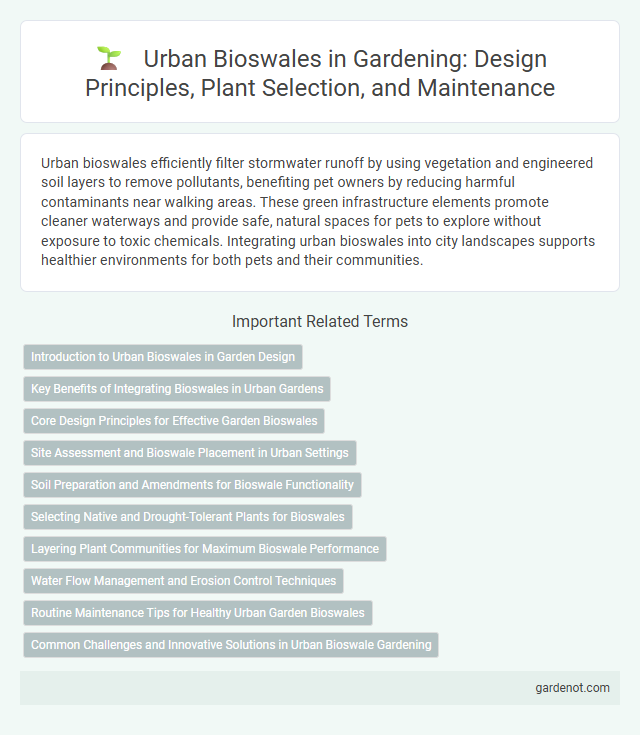Urban bioswales efficiently filter stormwater runoff by using vegetation and engineered soil layers to remove pollutants, benefiting pet owners by reducing harmful contaminants near walking areas. These green infrastructure elements promote cleaner waterways and provide safe, natural spaces for pets to explore without exposure to toxic chemicals. Integrating urban bioswales into city landscapes supports healthier environments for both pets and their communities.
Introduction to Urban Bioswales in Garden Design
Urban bioswales are landscape elements designed to manage stormwater runoff by filtering pollutants and improving water quality in urban gardens. These vegetated channels incorporate native plants and engineered soil layers to enhance infiltration and reduce flooding risks while promoting biodiversity. Integrating bioswales into garden design supports sustainable urban drainage systems and contributes to ecological resilience in densely populated areas.
Key Benefits of Integrating Bioswales in Urban Gardens
Urban bioswales enhance stormwater management by filtering pollutants and reducing runoff, improving water quality in city environments. They support biodiversity by providing habitat for native plants and beneficial insects, promoting urban ecological balance. Bioswales also contribute to urban cooling and aesthetic improvements, increasing green space value and residents' well-being.
Core Design Principles for Effective Garden Bioswales
Urban bioswales integrate vegetation, soil, and engineered components to effectively manage stormwater runoff by promoting infiltration and pollutant removal. Core design principles for garden bioswales emphasize proper grading for water flow control, selection of native, drought-tolerant plants that enhance water absorption, and the incorporation of layered soil media to maximize filtration and support root growth. Maintaining adequate size and slope ensures optimal hydraulic performance, while integrating overflow mechanisms prevents flooding during heavy rain events.
Site Assessment and Bioswale Placement in Urban Settings
Urban bioswale site assessment involves evaluating soil permeability, existing drainage patterns, and stormwater runoff volumes to optimize water infiltration and pollutant removal. Strategic bioswale placement prioritizes locations adjacent to impervious surfaces, such as roads and parking lots, to intercept runoff before entering municipal storm drains. Careful integration with urban infrastructure minimizes flooding risks and enhances groundwater recharge within densely populated areas.
Soil Preparation and Amendments for Bioswale Functionality
Urban bioswale soil preparation involves removing compacted layers and ensuring proper grading to promote water infiltration and prevent surface runoff. Incorporating organic amendments such as compost improves soil structure, enhances microbial activity, and increases nutrient retention essential for stormwater management. Selecting soil mixtures with optimal porosity and permeability supports efficient pollutant filtration and plant growth, critical for bioswale functionality in urban environments.
Selecting Native and Drought-Tolerant Plants for Bioswales
Selecting native and drought-tolerant plants for urban bioswales enhances water absorption and reduces maintenance requirements. Native species support local biodiversity and are adapted to regional soil and climate conditions, promoting long-term sustainability. Incorporating drought-tolerant plants minimizes irrigation needs while maintaining effective stormwater filtration and soil stabilization.
Layering Plant Communities for Maximum Bioswale Performance
Layering plant communities in urban bioswales enhances stormwater filtration by combining deep-rooted perennials, native grasses, and groundcovers that improve soil permeability and pollutant uptake. Diverse vegetation layers support microbial activity crucial for breaking down contaminants and increase water retention during heavy rainfall. Strategic plant selection tailored to local climates maximizes bioswale efficiency and resilience in urban environments.
Water Flow Management and Erosion Control Techniques
Urban bioswales utilize engineered soil layers and dense native vegetation to effectively manage stormwater flow by promoting infiltration and slowing runoff velocity. These systems incorporate check dams, gradient adjustments, and rock-lined channels to stabilize water flow while minimizing soil erosion. Properly designed bioswales reduce urban flooding risks and prevent sediment transport, enhancing overall water quality in metropolitan areas.
Routine Maintenance Tips for Healthy Urban Garden Bioswales
Routine maintenance of urban bioswales is essential to ensure optimal stormwater management and pollutant filtration. Regularly inspecting for sediment accumulation and removing debris preserves water flow and prevents clogging in bioswale channels. Maintaining native vegetation through pruning, weeding, and periodic replanting sustains soil stability and enhances the bioswale's ecological functions.
Common Challenges and Innovative Solutions in Urban Bioswale Gardening
Urban bioswales face common challenges such as soil compaction, limited space, and pollution runoff that reduce their effectiveness in stormwater management. Innovative solutions include using engineered soils with enhanced permeability, integrating native plant species for better pollutant filtration, and implementing modular bioswale designs to optimize space in dense urban areas. Advanced monitoring technologies also help in real-time water quality assessment and maintaining bioswale performance.
Urban bioswale Infographic

 gardenot.com
gardenot.com